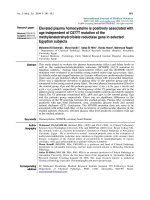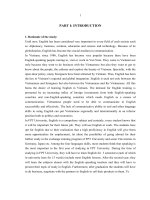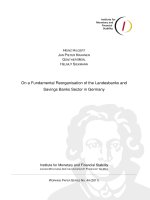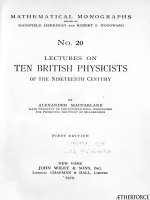teachings on peace and harmony of the 14th dalai lama and selected peace advocates
Bạn đang xem bản rút gọn của tài liệu. Xem và tải ngay bản đầy đủ của tài liệu tại đây (931.57 KB, 186 trang )
THAI NGUYEN UNIVERSITY
Socialist Republic of Vietnam
BATANGAS STATE UNIVERSITY
Republic of the Philippines
i
THE TEACHINGS ON PEACE AND HARMONY OF THE 14
TH
DALAI
LAMA AND SELECTED PEACE ADVOCATES
A Dissertation
Presented to the
Faculty of the Graduate School
Batangas State University
Batangas City
In Partial Fulfillment
of the Requirements for the Degree
Doctor of Philosophy in English Language and Literature
by
TRAN THI NHI
2014
THAI NGUYEN UNIVERSITY
Socialist Republic of Vietnam
BATANGAS STATE UNIVERSITY
Republic of the Philippines
ii
ABSTRACT
Title: Teachings on peace and harmony of the 14
th
Dalai
Lama and selected peace advocates
Author: Tran Thi Nhi
Course: Doctor of Philosophy in English language and literature.
Year: 2014
Advisor: Dr. Maria Luisa A. Valdez
Summary
This study analyzed the selected works by the 14
th
Dalai Lama, a
modern day leading figure of peace, and some other authors namely
Mawlana Rumi, Rabindranath Tagore, Pope John Paul II and Daisaku
Ikeda to explore how peace and harmony is conceptualized by these
peace advocates. Likewise, the study aimed to reveal the universal
concepts of peace and harmony shared by the peace advocates as the
representatives of different cultures and religions. The research also
discussed and how their common teachings on peace and harmony
have been transferred into a global peace movement.
Although these peace movement leaders represent different
religions and come from different cultures, they share much in common in
THAI NGUYEN UNIVERSITY
Socialist Republic of Vietnam
BATANGAS STATE UNIVERSITY
Republic of the Philippines
iii
espousing their view on peace as a way of life. In this study the author
attempts to weave a mosaic of universal and permanent moral values
and principles, rooted in the teachings of these advocates for peace.
This mosaic promotes a spirit of respecting cultural pluralism, cultivate
human good qualities and appraise responsibility must be integrated in
education so that the young generation’s peace spirit is fostered,
energized and enlivened through literature and culture. She proposes
the adoption of this new paradigm for living in the modern world.
THAI NGUYEN UNIVERSITY
Socialist Republic of Vietnam
BATANGAS STATE UNIVERSITY
Republic of the Philippines
iv
ACKNOWLEDGEMENT
This has been a wonderful life changing experience for which I
am so very grateful. It would not have been possible without the
kindness and generosity of several people.
I wish to acknowledge my special debt and my deepest gratitude
to Dr. Maria Luisa A. Valdez, my supervisor, whose generous help and
constant encouragement have been valuable. Her intellectual curiosity,
dedication, openness and humility have showed me a model of
scholarly endeavour that will follow me for my whole life. My study of
peace and harmony began under her inspiring direction.
I would also like to sincerely thank the faculty at the Graduate
School, Batangas State University for their invaluable guidance and
support throughout my studies. My thanks should go to my colleagues
and at Thai Nguyen School of Foreign Languages, Vietnam for their
encouragement and support.
For setting an example to aspire to, as well as for his friendship, I
thank Dr. Melvyn Sakaguchi.
Finally, my special thanks should be expressed to my family and
friends for their unconditional love, support and their trust in my ability to
complete this.
THAI NGUYEN UNIVERSITY
Socialist Republic of Vietnam
BATANGAS STATE UNIVERSITY
Republic of the Philippines
v
TABLE OF CONTENTS
TITLE PAGE i
TABLE OF CONTENTS ii
THE PROBLEM 1
Introduction 1
Statement of the Problem 7
Scope, Delimitation and Limitations of the Study 8
Significance of the Study 10
REVIEW OF RELATED LITERATURE 14
Conceptual Literature 14
Synthesis of Literature Review 57
Definition of Terms 67
RESEARCH METHODOLOGY 71
ANALYSIS AND INTERPRETATION 78
SUMMARY, CONCLUSION AND RECOMMENDATION 169
THAI NGUYEN UNIVERSITY
Socialist Republic of Vietnam
BATANGAS STATE UNIVERSITY
Republic of the Philippines
1
Chapter I
THE PROBLEM
Introduction
There exist myriad problems in the current world which threaten
the existence of humanity. Violence is accelerating everywhere.
Ceaseless wars and conflicts are taking place in several regions, killing
thousands of people and causing suffering for millions of human beings.
Furthermore, more and more modern weapons with massive
destruction capacity are being produced, threatening the whole mankind
in every minute. Meanwhile, the world is also faced with terrorism,
environmental pollution, racial religious conflicts, political disputes,
social and economic inequality, the large gap between the rich and the
poor, diseases and poverty.
Making the situation worse, these problems happen in every
continent without exception, and tend to happen to not only one nation
or a few nations but also bigger groups of nations.
For example, the United States and Western countries have
recently experienced terrorist attacks, civil unrest and violent
massacres; the political disputes between Russia and other European
countries around the issues related to Ukraina has resulted in the
THAI NGUYEN UNIVERSITY
Socialist Republic of Vietnam
BATANGAS STATE UNIVERSITY
Republic of the Philippines
2
embargo and trade and business sanctions which creates hardships for
of millions of citizens in the European continent; the rise of terrorist
country self-called Isis has created turmoil and terrible violence in
Middle East and North Africa; constant conflicts in the China Sea are
threatening the stability and the maintenance of peace in the South East
Asia.
All of these catastrophic events beg the question of how to save
humanity.
As stated in the United Nations Educational, Scientific and
Cultural Organization (UNESCO) constitution, the statement that “Since
wars begin in the minds of men, it is in the minds of men that the
defenses of peace must be constructed” is an appeal for a psychology
of peace, a movement which seeks to find a the solution to conflicts
without violence but via mutual and harmonious relationships.
Accordingly, peace education is a principal means to maintain
and promote peace. To establish and foster a culture of peace is a
necessity for any nation, including Vietnam - a country vulnerable to
peace.
Aligning with UNESCO constitution, the country has been a long
time advocate for peace, maintaining and promoting education for
THAI NGUYEN UNIVERSITY
Socialist Republic of Vietnam
BATANGAS STATE UNIVERSITY
Republic of the Philippines
3
peace via its education policies implemented in both informal teaching
and formal education.
Peace education as a social movement can be traced back from
religious traditions. For centuries, peace and peaceful resolution of
conflict was primarily discussed in the teachings of religious leaders
such as Lao Tse, Jesus Christ, the Buddha, the Dalai Lama, and Bahau
llah, who taught that people were supposed to promote peace in their
lives and in the world as a whole.
The contribution that religious figures can make to peacemaking
has been increasingly studied and recognized. Peace education has
evolved from radical values in religious traditions of love, compassion,
tolerance and charity to modern theories revolving interpersonal
relations and environmental issues (Harris, 2002).
Buddhism, the religion which was introduced to Vietnam about
two thousand years ago, despite ups and downs, has tremendously
influenced all facets of Vietnamese culture, especially the spiritual life
and the system of moral values. Historically, most Vietnamese have
dentified themselves with Buddhism. Buddhism was introduced to
Vietnam as being a peaceful way, aimed at seeking justice,
compassion, freedom for humans from sufferings. These beliefs are
close to the long standing cultural values of the Vietnamese and
THAI NGUYEN UNIVERSITY
Socialist Republic of Vietnam
BATANGAS STATE UNIVERSITY
Republic of the Philippines
4
suitable with Vietnamese people, who advocate peace and always
desire happiness and freedom for their nation. Therefore, the religion
was easily accepted and quickly spread by the Vietnamese.
Throughout the country, there exist thousands of Buddhist
pagodas in the cities and the countryside, playing an important part in
the spiritual life and making an identified culture of the Vietnamese
people. These pagodas function not only as the place for communal
activities but also a place for ideological teachings to be conveyed.
Buddhism has been considered as the national religion of
Vietnam. During the Ly dynasty in the eleventh and twelfth century,
Buddhism was so popular and vibrant that half of the Vietnamese
population at that time followed it.
In the 20th century, the country experienced a series of harsh
historical events, affecting the development of the religion. However,
with recent changes in economics and social developments, the picture
of religious life within Vietnamese people has become more vivid. If in
the past, only old women went to the temples and practiced Buddhist
rituals, nowadays, there seems to be an increasing interest in practicing
the religion in both men and women, and in both old people and young
ones. This trend likely creates a a favorable environment to promote
peace education for the whole nation in general and for its young
THAI NGUYEN UNIVERSITY
Socialist Republic of Vietnam
BATANGAS STATE UNIVERSITY
Republic of the Philippines
5
generation in particular. It is undeniable that Buddhism has deep roots
in Vietnamese culture, since its principal beliefs and values can be
found in various facets of Vietnamese culture, from folklore, arts and
literature to many aspects of everyday life. The religion has been
imbedded in the common life of the Vietnamese communities.
The core value in the philosophy of Buddhism largely
recognized by the Eastern Buddhist countries and recently by
Western countries is its interpretation of peace and harmony, its
nature and the way to attain it.
For centuries, Buddhist countries have practiced the doctrine and
followed the teachings of Buddha. However, in the modern era where
rapid development in information technology is at hand, it is very timely
to contemplate if the Buddhist philosophy on peace and harmony is still
appropriate for the hectic and busy and frenetic life style experienced
by people in the present day.
The 14th Dalai Lama, Tenzin Gyatso, a Tibetan Buddhist monk,
has been the primary proselytizer and advocate of the philosophy of
peace and harmony from the perspective of Buddhism in recent times.
Notably, he has been successful in making relevant the thousand-year
wisdom of Buddhism to the specific and practical teachings for the
modern life of the new millennium.
THAI NGUYEN UNIVERSITY
Socialist Republic of Vietnam
BATANGAS STATE UNIVERSITY
Republic of the Philippines
6
Beside the Dalai Lama, there have been a great number of peace
advocates, including religious figures, political leaders, literary writers
and philosophers, who have advocated the teachings of peace and
harmony in their books, sermons and speeches. All of this have
provided a basis for a trend and a growing movement for peace and
harmony in modern times. Because of the importance of this peace
movement, the researcher has decided to focus on studying the works
of the Dalai Lama and a few other selected advocates of the peace
movement to have a deeper and holistic view on understanding of the
concepts of peace in current time and discuss the implications of this
movement for life in modern times, particularly its impact on Vietnamese
student values.
THAI NGUYEN UNIVERSITY
Socialist Republic of Vietnam
BATANGAS STATE UNIVERSITY
Republic of the Philippines
7
Statement of the Problem
This study is an analysis of the teachings on peace and harmony
of the 14th Dalai Lama and selected other notable peace advocates and
to integrate their viewpoints into a global peace education perspective.
Specifically, the study seeks answers to the following questions:
1. What are the teachings on peace and harmony held by the 14th Dalai
Lama?
2. What are the peace concepts that may be drawn from the works of
the following peace advocates:
2.1. Mawlana Rumi;
2.2. Rabindranath Tagore;
2.3. Pope John Paul II; and
2.4. Daisaku Ikeda?
3. What are the common aspects on the teachings of peace held by
these individuals ?
4. How may the varied teachings on peace be integrated in a global
peace education perspective and program?
THAI NGUYEN UNIVERSITY
Socialist Republic of Vietnam
BATANGAS STATE UNIVERSITY
Republic of the Philippines
8
Scope, Delimitation and Limitations of the Study
This study analyzes the philosophy of nonviolence as embodied
in the selected literary pieces of the 14th Dalai Lama and the selected
peace advocates Mawlana Rumi, Rabindranath Tagore, Pope John
Paul II and Daisaku Ikeda and focuses on its implication for Vietnamese
students’ values. This study employs the qualitative method of research
in analyzing the selected writings and speeches of the personages and
uses sociological and philosophical approaches as the bases for
analysis.
This study is anchored on Gultung’s theory on peace. Other
approaches in literary criticism that may be employed in the analysis
such as the Formalist Criticism, Biographical Criticism, Historical
Criticism, and Psychological Criticism are not part of this study.
The researcher also uses content analysis, which is a systematic
technique in analyzing message content and message handling. The
data analysis in this study centered on pattern seeking and the
extraction of meaning from the selected peace advocates’ selected
literary narrative or image data.
Much effort was focused on the task of recording data or making
notes through concepts and categories; altering or creating new codes
or more subtle categories; linking and combining abstract concepts;
THAI NGUYEN UNIVERSITY
Socialist Republic of Vietnam
BATANGAS STATE UNIVERSITY
Republic of the Philippines
9
extracting the essence; organizing meaning; creating theory from
emerging themes; writing an understanding; and drawing conclusions.
The essential features in the treatment of materials were
considered by the researcher in the conduct of this study.
The general rules cited by Stott (2014) as regards the seven
standards a piece of literature should have in order to be considered
literary served as a in the selection of works under study.
Applying these standards the following literary works were
analyzed: Dalai Lama’s The Power of Compassion, Infinite Compassion
for an Imperfect World, Beyond Religion - Ethics for a Whole World,
and Ancient Wisdom and Modern World - Ethics for the new Millennium.
The selected writings Rumi entitled Nasnavi, Tagore’s Gitanjali and
Nationalism , Pope John Paul’s Messages on the World Peace Day and
Daisaku Ikeda’s For the Sake of Peace: Seven Paths to Global
Harmony were also included. These prose and poetry pieces
constituted the primary resource materials for of the study.
However, since these individuals are not only well-known literati
but also social figures, religious leaders and philosophers; this study
also analyzed essays, works and recorded speeches, to provide as
comprehensive an assessments of their ideas as possible.
THAI NGUYEN UNIVERSITY
Socialist Republic of Vietnam
BATANGAS STATE UNIVERSITY
Republic of the Philippines
10
Significance of the Study
This approach - using literary analysis as a tool for eliciting the
meaning and significance of the materials analyzed makes this study
extremely beneficial to academic managers, working professionals,
media practitioners, college instructors of literature, students of
literature, members of the community, and other researchers.
Academic Managers. This dissertation will help policy makers
such as those from Vietnam’s Ministry of Education and Training,
include developmental priorities, programs, projects and policies in the
educational institutions to ensure that the concepts of peace and
harmony can access the academe. This will also inspire them to
develop peace-related activities in the curricula that will educate the
academic community of the beneficial outcomes of peace and harmony
to all people regardless of gender, race, nationality and religious
backgrounds and to serve as a bridge builder in interfaith encounter.
Working Professionals. This study will be beneficial for them in
the sense that the selected works have showcased how the 14th Dalai
Lama’s and the selected peace advocates’ activism which helped
shaped the people’s understanding of peace as a philosophy of life.
Likewise, they may be motivated to bring peace awareness in the
mainstream of their disciplines, their lives and the world and be inspired
THAI NGUYEN UNIVERSITY
Socialist Republic of Vietnam
BATANGAS STATE UNIVERSITY
Republic of the Philippines
11
to organize peace initiatives to nurture and challenge people of all ages
working in various sectors of society to a nonviolent life. These
initiatives may help the working people to embrace this advocacy, clarify
life goals, and revitalize working relationships within their workplaces.
Media Practitioners. This study may inspire them to introduce an
intervention strategy referred to as entertainment education to change
cultural attitudes, norms and behaviors that would benefit audiences.
This strategy incorporates educational messages on peace and
harmony into soap operas and other media programming on the
television and radio to change the attitudes and behavior of the
audience.
College Instructors of Literature. This analysis will be helpful in
the instructor’s methodology in teaching literature as an inquiry into
using the appropriate literary theories and approaches in literary
analysis. This will lead to treating literary criticism as a worthwhile
exercise that includes, among others, the identification of a meaningful
themes and the investigation of literary devices to reveal such themes.
In addition, this will provide them with opportunities to focus on the
concept of peace and harmony in their literature classes and open their
students’ mind and hearts to the varied teachings on peace that can be
integrated on a global peace education perspective.
THAI NGUYEN UNIVERSITY
Socialist Republic of Vietnam
BATANGAS STATE UNIVERSITY
Republic of the Philippines
12
Students of Literature. Not only will this analysis give them an
extensive and profound outlook in life with reference to peace and
harmony through the lives and experiences of the writers and the
characters in the selected literary pieces, it will also make them realize
that issues in relation to violence should not be tolerated. In addition,
this paper will make them treat literature as a work of art distinguished
from other texts through content and form, and eventually intensify their
appreciation of prose and poetry and inspire them to engage in literary
analysis as an academic activity.
Members of the Community. This paper will make them more
aware of their social responsibility and peace work to curb violence that
beset the community and the world today. This will make them
understand that peace and harmony is most effective when it highlights
the positive interdependence existing among the people, groups,
organizations and nations involved and the need for joint efforts to
achieve mutual benefits. It will also make them aware that integrative
agreements maximize mutual benefits; and that the use of a procedure
of decision making that creates a synthesis or integration of various
preferences of the involved parties or takes everyone’s perspectives
and conclusions into account. Likewise, the analysis will sensitive
people to the fact that some of the belief systems and practices at
THAI NGUYEN UNIVERSITY
Socialist Republic of Vietnam
BATANGAS STATE UNIVERSITY
Republic of the Philippines
13
home and the community are oftentimes not in accordance with the
establishment of valued roles in relation to peace and harmony for
young Vietnamese students, and thus should be avoided.
Other Researchers. This paper may inspire them to conduct
more researches on ways that are most effective in integrating the
nonviolent principles into the people’s dominant worldview. Researches
on peace and nonviolence and tolerant values and worldviews might
diminish the negative aspects of fear and mortality salience that is
usually associated with terror management. Likewise, researchers will
be benefitted by this study through the analysis and treatment of
materials, and through the careful investigation of both theme and form
in literary genres. This paper may also show them the process of
drawing out literary theories and utilizing critical approaches in literary
analysis.
THAI NGUYEN UNIVERSITY
Socialist Republic of Vietnam
BATANGAS STATE UNIVERSITY
Republic of the Philippines
14
Chapter II
REVIEW OF RELATED LITERATURE
The following review of literature is presented with the end view
of identifying the constructs of the study.
Conceptual Literature
The review of the conceptual literature yields four types of
constructs, which may be used in the analysis and interpretation of the
novels to be dissected. These constructs include the 14th Dalai Lama
and his significant works; the other selected peace advocates and their
significant works; peace education and culture of peace; and
philosophical and sociological approaches in literary criticism
The 14
th
Dalai Lama and His Significant Works
The incumbent Dalai Lama is the 14th and was born in 1935 as
Lhamo Thondup in north-east Tibet. Tibetan Buddhists regard every
Dalai Lama as a reincarnation of Avalokiteshvara1, the bodhisattva2 of
compassion.
Lhamo was recognized as the Dalai Lama at the age of four and
was raised in Potala Palace, Lhasa. His name was changed to Jetsun
Jamphel Nigawang Lobrang Yeshe Tenzin Gyatso, which means “Holy
THAI NGUYEN UNIVERSITY
Socialist Republic of Vietnam
BATANGAS STATE UNIVERSITY
Republic of the Philippines
15
Lord, Gentle Glory, Compassionate, Defender of the Faith, Ocean of
Wisdom”, though he is often simply called Kundun - “The Presence”.
His monastic education began at the age of six, and at 23 he was
awarded the Lharampa degree (the highest level geshe degree, or
doctorate of Buddhist philosophy). With China's occupation of Tibet in
1959, His Holiness fled to northern India, where he established a
Tibetan Government-in-Exile, shepherding the exile Tibetan community
towards a modern democracy. Today His Holiness concentrates on his
spiritual mission and is recognized worldwide for his message of peace,
non-violence, inter-religious understanding, universal responsibility and
compassion.
In December, 1989 the Dalai Lama was awarded the Nobel
Peace Prize. In October 2007 President George Bush described him as
“a universal symbol of peace and tolerance” when the 72-year-old was
awarded the US Congregational Medal, the highest civilian award
bestowed by the US legislature for his “many enduring and outstanding
contributions to peace, non-violence, human rights and religious
understanding.” In encouraging the Chinese government to dialogue
with the Dalai Lama, President Bush said China’s leaders will find “this
good man to be a man of peace and reconciliation.”
THAI NGUYEN UNIVERSITY
Socialist Republic of Vietnam
BATANGAS STATE UNIVERSITY
Republic of the Philippines
16
Many in the West who are attracted by the Dalai Lama see him
as one who epitomizes inner peace, kindness and compassion. People
read his books and listen to his talks in the hope that he might help
them live a better life and become more content and happy. His
literature draws huge crowds, sometimes as many as 20,000,037
(Wilson, 2007).
In his book, Ethics for the New Millennium (1999), Dalai Lama
discusses positive ethical conduct. He attempts, however, to approach
this subject from what he calls universal rather than religious principles.
He states that he has come to the conclusion that whether or not a
person is a religious believer does not matter much in his or her ethical
conduct. Far more important in that consideration is that he or she is a
good human being. Yet, he does base his discussion on the Buddhist
perspective that all individuals strive to be happy and avoid suffering. In
his narrative, everything people do, not only as individuals but also at
the level of society, can be seen in terms of this fundamental aspiration.
This approach is consistent with that of most world religions that direct
their attentions to helping human beings achieve lasting happiness.
His Holiness stresses that those living in the materially developed
countries for all their industry, are in some ways less satisfied, are less
happy, and to some extent suffer more than those living in the less
THAI NGUYEN UNIVERSITY
Socialist Republic of Vietnam
BATANGAS STATE UNIVERSITY
Republic of the Philippines
17
developed countries of the world. As an equal concern, he argues that
individuals sense that their futures are dependant not on their neighbors
but rather on their jobs or employers. He is concerned that individuals
suppose that others are not important in their life and therefore their
happiness is not important. He states that individuals now live in a
society where people find it harder and harder to show one another
basic affection. He posits that individuals may no longer know how to
act in a moral sense. Though individuals are basically kind and
compassionate, they are capable of cruelty and hatred. Therefore,
people must struggle to have better conduct in their dealings with
others.
The Dalai Lama stresses that most individuals have a ‘spiritual’
side of their character that actually has a level of concern for the well-
being of others. He argues that individuals do not like to see others
suffering. He further argues that people’s experience with suffering
connects them to others. These experiences are the basis for an
individual’s capacity for empathy.
The Dalai Lama asks for a radical reorientation away from the
habitual preoccupation with self and an adoption of the characteristics
mentioned above. To show ethical restraint, according to the Dalai
Lama, one adopts love, compassion and the qualities of sympathy
THAI NGUYEN UNIVERSITY
Socialist Republic of Vietnam
BATANGAS STATE UNIVERSITY
Republic of the Philippines
18
mentioned above. Returning to this Buddhist roots, the Dalai Lama
states “ establishing binding ethical principles is possible when we
take as our starting point the observation that we all desire happiness
and wish to avoid suffering.” An act that harms another individual or
does violence to another individual is potentially an unethical act.
Ethical acts refrain from causing harm to others’ experiences or
expectations of happiness. The more people develop compassion, the
more genuinely ethical their conduct will be. According to His Holiness,
in order to act in a consistently compassionate manner, one must
develop an ethic of virtue.
The Dalai Lama calls for a sense of universal responsibility. As
part of universal responsibility he argues that individuals must commit
themselves to honesty. If people develop an attitude of responsibility
toward others they can begin to create the kinder and more
compassionate world that His Holiness is seeking. He suggests that
individuals should learn to treat everyone as if they were a close friend.
Similar arguments are put forward in the text The Art of Living, A
Guide to Contentment, Joy, and Fulfillment. The basis for this book was
taken from a series of public lectures given by His Holiness the Dalai
Lama at Wembley Conference Centre in London, England in May of
1993. The Dalai Lama, in this text, again stresses that “ all sentient
THAI NGUYEN UNIVERSITY
Socialist Republic of Vietnam
BATANGAS STATE UNIVERSITY
Republic of the Philippines
19
beings, particularly human beings, want happiness and do not want
pain and suffering”. He goes on to argue that good conduct by an
individual is the way in which life becomes more meaningful, more
constructive, and more peaceful.
Another work of the Dalai Lama to mention is How to Practice,
The Way to a Meaningful Life. In this work the Dalai Lama again
emphasizes that “we want happiness and do not want suffering”. In this
text the Dalai Lama suggests a series of Tibetan traditions that are
intended to help an individual gain a warm heart, a respect for others,
and a general concern for the welfare of others. Showing compassion,
however, is still the underlying theme of this text. The Dalai Lama
states, “I believe that the practice of compassion and love - a genuine
sense of brotherhood and sisterhood - is the universal religion.” The
Dalai Lama goes on to state that “the morality of concern for others -
called the morality of Budhisattvas (being primarily concerned with
helping others) - is mainly practiced by restraining the mind from falling
into selfishness”. The Dalai Lama advocates that compassion is the key
to achieving a deeper level of morality.
Another major important work is Essential Teachings (1995) .
Since this book was published, the Tibetan diaspora and the character
of the Tibetan people has become better understood. Their naturally
THAI NGUYEN UNIVERSITY
Socialist Republic of Vietnam
BATANGAS STATE UNIVERSITY
Republic of the Philippines
20
open and dynamic nature and their courageous adaptation to exile has
made them much appreciated in the countries that have welcomed
them. His Holiness the Dalai Lama has also become more familiar in
the West, paralleling the rapid spread of Buddhism in which he occupies
a prominent position. If for the Tibetans the Dalai Lama is the symbol of
their lost country and their cherished faith, for Westerners he is the
protector who gives access to the vast Buddhist teachings.
His teachings have a special flavour. He can open the minds of
his listeners to a comprehension they would never be able to reach by
themselves, because before all else he has realised what he teaches.
He himself has said, 'One who teaches should speak only of what he
has experienced; merely enumerating theories will offer little
encouragement and will not be a sufficient base for the study of
Dharma. If that which I tell you is in accord with lived experience, it will
give you, I am sure of it, strength and inspiration.'
There are two aspects of the approach to Buddhism: the study of
doctrine, and then its application in practice. In both approaches, the
Dalai Lama's contribution towards the development of Buddhism in the
West is extremely important. The Dalai Lama is invaluable because he
represents Buddhism in its wholeness. He does not limit himself to any
of the four Tibetan traditions: the Nyingma-pa, the oldest; the Sakya-pa;









